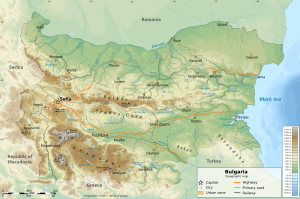 | |
| Continent | Europe |
|---|---|
| Region | Balkan Peninsula, Southeast Europe |
| Coordinates | 42°45′N 25°30′E / 42.750°N 25.500°E |
| Area | Ranked 103rd |
| • Total | 110,993.6[1] km2 (42,854.9 sq mi) |
| Coastline | 378 km (235 mi) |
| Borders | 1,867 km |
| Highest point | Musala,[2] 2,925 m (9,596 ft) |
| Lowest point | Black Sea, 0 m |
| Longest river | Iskar River, 368 km (229 mi) |
| Largest lake | Lake Burgas 27 km2 (10 sq mi) |
| Climate | temperate in north to Mediterranean in south |
| Terrain | mountains and hills with lowlands in north and southeast |
| Natural resources | copper, lead, zinc, coal, timber, arable land |
| Natural hazards | earthquakes (in certain areas), floods, landslides |
| Environmental issues | air and water pollution, deforestation, soil contamination[3] |
| Exclusive economic zone | 110,879 km2 (42,811 sq mi) |
Bulgaria is a country situated in Southeast Europe that occupies the eastern quarter of the Balkan peninsula, being the largest country within its geographic boundaries. It borders Romania to the north, Serbia and North Macedonia to the west, Greece and Turkey to the south, and the Black Sea to the east. The northern border with Romania follows the river Danube until the city of Silistra. The land area of Bulgaria is 110,994[1] square kilometres (42,855 sq mi) (111,002[1] square kilometres (42,858 sq mi)), slightly larger than that of Cuba, Iceland or the U.S. state of Tennessee. Considering its relatively compact territorial size and shape, Bulgaria has a great variety of topographical features. Even within small parts of the country, the land may be divided into plains, plateaus, hills, mountains, basins, gorges, and deep river valleys. The geographic center of Bulgaria is located in Uzana.
Bulgaria features notable diversity with the landscape ranging from the snow-capped peaks in Rila, Pirin and the Balkan Mountains to the mild and sunny Black Sea coast and southernmost valleys; from the typically continental Danubian Plain (ancient Moesia) in the north to the strong Mediterranean climatic influence in the valleys of Macedonia and in the lowlands in the southernmost of Thrace, the lowest parts of the Upper Thracian Plain, along the Maritsa River, the Southern Bulgarian Black Sea Coast. Most of the country is situated within the humid continental climate region, with Alpine climate in the highest mountains and subtropical climate in the southernmost regions.[4]
The country has a dense river network but with the notable exception of the river Danube, rivers are mostly short and with low water flow.[5] The average annual precipitation is 670 mm; the rainfall is lower in the lowlands and higher in the mountains. The driest region is Dobrudzha in the north-eastern part of the Danubian Plain (450 mm), while the highest rainfall has been measured in the upper valley of the river Ogosta in the western Balkan Mountains (2293 mm).[6]
Bulgaria has substantial land in agriculture and forest. In 2006 land use and land cover was 5% intensive human use, 52% agriculture including pasture, 31% forest, 11% woodland-shrub, grassland, and non-vegetated, and 1% water.[7]
Phytogeographically, Bulgaria straddles the Illyrian and Euxinian provinces of the Circumboreal Region within the Boreal Kingdom. The country falls within six terrestrial ecoregions of the Palearctic realm: Balkan mixed forests (main), Rodope montane mixed forests (main in the mountains), Euxine-Colchic deciduous forests, Aegean and Western Turkey sclerophyllous and mixed forests, East European forest steppe and Pontic–Caspian steppe.[8]
- ^ a b c Penin, Rumen (2007). Природна география на България [Natural Geography of Bulgaria] (in Bulgarian). Bulvest 2000. p. 18. ISBN 978-954-18-0546-6.
- ^ "Musala". Българска енциклопедия А-Я (in Bulgarian). Bulgarian Academy of Sciences / Trud. 2002. ISBN 954-8104-08-3. OCLC 163361648.
- ^ Kanev, Petar (2009). "Bulgaria from space: Logging, concrete and hope". *8* Magazine (in Bulgarian) (2/09).
- ^ Donchev & Karakashev 2004, pp. 55, 59–61
- ^ Cite error: The named reference
donchev68was invoked but never defined (see the help page). - ^ Donchev & Karakashev 2004, pp. 57–58
- ^ "European Union Project CORINE, "CLC2006 technical guidelines"". 18 December 2007. Retrieved 8 March 2016.
- ^ "Ecoregions of Bulgaria". The Encyclopedia of Earth. Retrieved 19 July 2015.